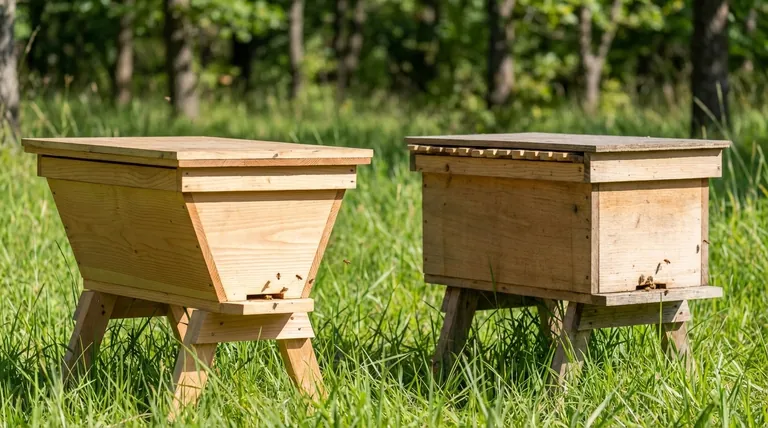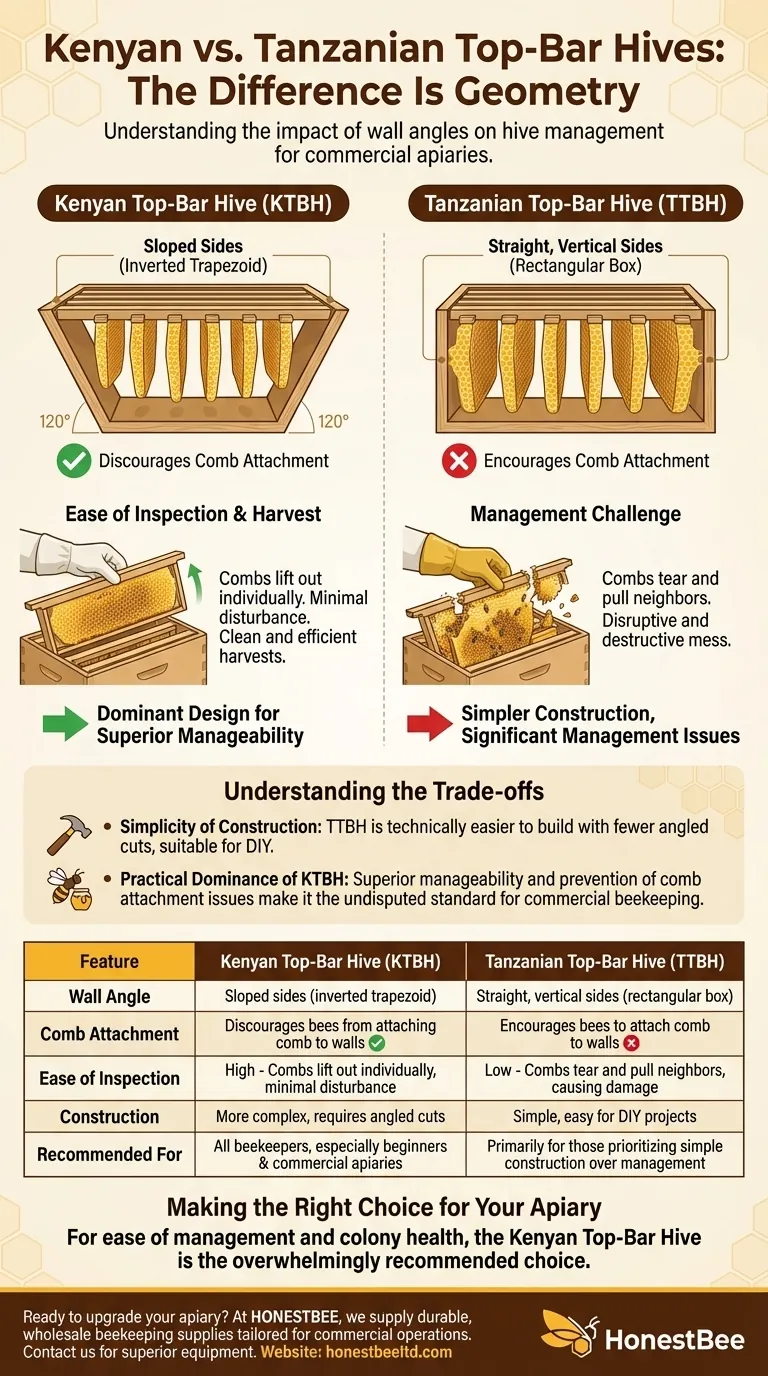The fundamental difference is geometry. The Kenyan Top-Bar Hive (KTBH) features sloped sides, creating a body shaped like an inverted trapezoid. In contrast, the original Tanzanian Top-Bar Hive (TTBH) has straight, vertical sides, forming a simple rectangular box. This single design choice has significant implications for hive management.
The core issue isn't the shape itself, but how bees interact with it. The KTBH's sloped sides discourage bees from attaching their comb to the hive walls, making inspections and harvests dramatically easier. This key advantage is why the Kenyan design has become the dominant and preferred model for horizontal top-bar beekeeping.

The Core Design Distinction: Wall Angle
The shape of the hive body directly influences bee behavior and, consequently, the beekeeper's experience. Both hives are horizontal and use removable bars, but the angle of the walls is the critical difference.
The Kenyan Top-Bar Hive (KTBH)
The KTBH is defined by its sides, which are sloped inwards at an angle (typically around 120°). This shape is intentionally designed to mimic the natural, hanging shape of a honeycomb.
Because the walls are not vertical, the bees are far less likely to attach their comb to the sides as they build it downwards from the top bar.
The Tanzanian Top-Bar Hive (TTBH)
The TTBH is a simpler design, consisting of a rectangular box with straight, 90-degree side walls. It was developed independently of the Kenyan hive.
While straightforward to construct, its vertical walls present a surface that bees readily attach their comb to for structural support.
Why the Angle Matters: Bee Behavior and Management
The seemingly minor difference in wall angle has a profound impact on the most common tasks a beekeeper performs. The goal of any manageable hive is to be able to remove and inspect one frame or bar at a time without destroying comb or agitating the colony.
The Critical Factor: Comb Attachment
Bees naturally seek to secure their comb. In a hive with vertical walls like the TTBH, they will firmly attach the edges of the comb to the sidewalls.
This attachment creates a significant problem. When you try to lift a single top bar, the attached comb will tear, or it will pull up the neighboring combs, causing a disruptive and destructive mess.
Ease of Inspection and Harvest
The sloped walls of the KTBH create a natural gap between the descending comb and the hive body. This ensures each comb hangs freely from its own top bar.
This separation is the Kenyan design's primary advantage. It allows the beekeeper to lift, inspect, and return each bar individually with minimal disturbance to the bees or damage to the comb. This makes routine checks and honey harvesting clean and efficient.
Understanding the Trade-offs
While one design has proven more practical, it's useful to understand why the other exists. The choice often comes down to a trade-off between construction simplicity and long-term manageability.
The Simplicity of the Tanzanian Design
The main advantage of the straight-sided TTBH is its ease of construction. Building a simple rectangular box requires fewer angled cuts and less precision than building a KTBH. This makes it a more accessible do-it-yourself project.
The Practical Dominance of the Kenyan Design
Despite its slightly more complex construction, the superior manageability of the KTBH has made it the undisputed standard. Its design prevents the frustrating comb-attachment issues inherent in the TTBH.
As a result, virtually all commercially available top-bar hives today use the sloped-sided Kenyan design, even if they are not explicitly labeled as such.
Making the Right Choice for Your Goal
Your decision should be guided by your priorities for beekeeping and your willingness to deal with potential challenges.
- If your primary focus is ease of management and colony health: Choose the Kenyan Top-Bar Hive. The sloped sides are a critical feature for non-disruptive inspections and are essential for a positive beekeeping experience.
- If your primary focus is absolute simplicity in construction: The Tanzanian design is technically easier to build, but you must be prepared for the significant management challenge of attached combs.
- If you are a beginner beekeeper: The Kenyan model is the overwhelmingly recommended choice. Its user-friendly design simplifies hive handling and prevents common frustrations.
Ultimately, selecting the hive with sloped sides empowers you to work with your bees' natural tendencies, not against them.
Summary Table:
| Feature | Kenyan Top-Bar Hive (KTBH) | Tanzanian Top-Bar Hive (TTBH) |
|---|---|---|
| Wall Angle | Sloped sides (inverted trapezoid) | Straight, vertical sides (rectangular box) |
| Comb Attachment | Discourages bees from attaching comb to walls | Encourages bees to attach comb to walls |
| Ease of Inspection | High - Combs lift out individually, minimal disturbance | Low - Combs tear and pull neighbors, causing damage |
| Construction | More complex, requires angled cuts | Simple, easy for DIY projects |
| Recommended For | All beekeepers, especially beginners | Primarily for those prioritizing simple construction over management |
Ready to build or upgrade your apiary with the right equipment?
At HONESTBEE, we supply durable, well-designed beekeeping supplies and equipment tailored for commercial apiaries and distributors. Whether you're standardizing on the superior Kenyan Top-Bar Hive or need other essential gear, our wholesale-focused operations ensure you get reliable products that make hive management easier and more productive.
Contact HONESTBEE today to discuss your equipment needs and get a quote!
Visual Guide

Related Products
- HONESTBEE Professional Hive Top Bee Feeder Feeding Solution
- Professional Hive Top Bee Feeder for Beekeeping
- HONESTBEE Advanced Ergonomic Stainless Steel Hive Tool for Beekeeping
- HONESTBEE Professional Long Handled Hive Tool with Precision Cutting Blade
- HONESTBEE Round Hive Top Bee Feeder for Syrup
People Also Ask
- How do I keep bees from drowning in my top feeder? Ensure Safe Feeding for Your Hive
- How is the plywood floor fitted into the hive-top feeder? Ensure Longevity with a Floating Floor Design
- What is a top feeder for bees? Maximize Colony Health with Efficient Feeding
- What are the advantages of hive top feeders? Maximize Feeding Efficiency for Your Apiary
- What is the best way to top feed bees? A Safe, High-Volume Feeding Solution for Your Apiary



















